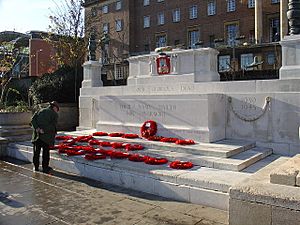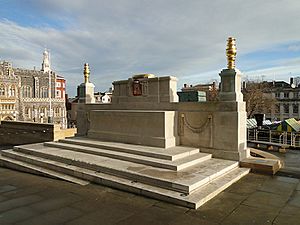Norwich War Memorial facts for kids
Quick facts for kids Norwich War Memorial |
|
|---|---|
| United Kingdom | |
 |
|
| For servicemen from Norwich killed in the First World War | |
| Unveiled | 1927 |
| Location | 52°37′43″N 1°17′32″E / 52.62858°N 1.29234°E Market Place, Norwich, Norfolk
|
| Designed by | Sir Edwin Lutyens |
|
OUR GLORIOUS DEAD / THEIR NAME LIVETH / FOR EVERMORE / REMEMBERING ALSO ALL OTHERS OF THIS CITY WHO HAVE GIVEN THEIR LIVES IN THE SERVICE OF THEIR COUNTRY
|
|
|
Listed Building – Grade II
|
|
| Official name | War Memorial and War Memorial Garden Terrace |
| Designated | 30 September 1983 |
| Reference no. | 1051857 |
The Norwich War Memorial is a special monument in Norwich, England. It remembers the soldiers from Norwich who died in the First World War. This memorial was designed by Sir Edwin Lutyens, a very famous architect. It was the last of eight similar monuments, called cenotaphs, that he built in England.
Before this memorial was built, people in Norwich had tried to create other ways to remember their war heroes, but these plans didn't work out. In 1926, the new leader of Norwich, the Lord Mayor, really wanted a memorial built. He asked Sir Edwin Lutyens to design it. Lutyens created a design that looks like an empty tomb, called a cenotaph. It has a low wall and a special stone called a Stone of Remembrance. There are also bronze torches, called flambeaux, that can burn gas to make a flame. Lutyens also designed a list of names, called a roll of honour, which is kept in Norwich Castle.
A soldier who was injured in the war officially opened the memorial on October 9, 1927. It was later moved in 1938 to a new spot between the market and the City Hall. This new area became a special memorial garden. In 2004, parts of the garden became unsafe, and the memorial was closed for repairs. The work finished in 2011. During this time, the memorial was fixed up and turned to face the City Hall. It was officially opened again on Armistice Day in 2011. Today, it is a very important historical building.
Contents
Why Norwich Needed a Memorial
The Norfolk Regiment was one of the first British army groups to fight in the First World War. They were sent to France in August 1914 and fought in early battles like the Battle of Mons. Other parts of the regiment fought in places like Iraq. Many men from Norwich joined the army, not just the Norfolk Regiment.
After the war, many towns in Britain built memorials because so many people had died. Sir Edwin Lutyens was a leading architect for these memorials. He designed the famous The Cenotaph in London, which is where national Remembrance Day events happen. He also designed the Thiepval Memorial to the Missing, the biggest British war memorial in the world. The Stone of Remembrance, which is part of the Norwich memorial, is also one of his designs.
Building the Memorial
Norwich's memorial was one of the last ones Lutyens built. Earlier ideas for a memorial in Norwich, like an agricultural college, didn't work out. They were too big or didn't appeal to everyone.
In 1926, Charles Bignold became the Lord Mayor of Norwich. He was determined to build a war memorial. He hired Lutyens, and they chose a spot near the Guildhall in June 1927. The mayor also wanted the project to help living people. So, he started an appeal to raise money for local hospitals and the memorial.
The memorial cost about £2,700 in 1927. Lutyens' fee was 10% of this. Some people in Norwich worried the design wouldn't fit with the city's old buildings. But Mayor Bignold believed the central location was perfect. He said Lutyens was an expert, having designed London's Cenotaph, and that his design was the best for the money they had.
The memorial couldn't list all 3,544 names of Norwich's war dead. So, Lutyens also designed a special "Roll of Honour." This was made of oak panels that fold out to show the names inside.
Memorial Design and Features
The memorial is made from Portland stone. It has a low wall with a tomb-like structure, called a cenotaph, on top. This cenotaph has a carved wreath. Norwich's city symbol is carved and painted onto the tomb, held by two angel figures.
On each side of the memorial, there are tall stands with bronze torches, called flambeaux. These torches are covered in gold leaf. The memorial is special because it's the only one Lutyens designed that can actually burn gas to create a flame from these torches.
A Stone of Remembrance sticks out from the wall below the city's symbol. This is the only time Lutyens put a Stone of Remembrance directly into a larger monument. Inside the memorial, there were two metal boxes. One held a list of Norwich's war dead. The contents of the second box are still a mystery.
The memorial has important words carved into it. Above the stone, it says: "OUR GLORIOUS DEAD." On the stone itself, it reads: "THEIR NAME LIVETH FOR EVERMORE." Later, another line was added at the bottom: "REMEMBERING ALSO ALL OTHERS OF THIS CITY WHO HAVE GIVEN THEIR LIVES IN THE SERVICE OF THEIR COUNTRY." The dates of the two world wars were also added to the wall.
The Roll of Honour, with all the names, took longer to finish. It was delivered in 1929 but wasn't very good quality at first. After improvements, it was finally placed in Norwich Castle in 1931.
History of the Memorial
General Sir Ian Hamilton officially opened the memorial on Sunday, October 9, 1927. Sir Edwin Lutyens was also there. A local veteran named Bertie Withers unveiled it. Bertie was chosen because he was from Norwich, joined the army early, fought overseas, and was permanently injured in the war. He lost his left leg after fighting in the Gallipoli Campaign and the First Battle of Gaza.
In 1938, the memorial was moved as part of a city improvement project. It became the main feature of a new memorial garden between the new City Hall and the castle. King George VI opened this garden on October 29, 1938. The memorial now stands on a raised area with steps leading up to it. There are also lamp-posts and flagpoles around it.
In the early 2000s, problems were found with the structure under the garden. The garden was closed and fenced off in 2004. The memorial stayed fenced off for seven years because the city council didn't have enough money for repairs. A journalist, Martin Bell, even said in 2007 that a war memorial in such a state would usually only be found in Iraq.
Repair work on the garden and its structure began in early 2008. The beams supporting the garden had become very weak. Work on the memorial itself started in September 2009. During the repairs, the memorial was turned to face the City Hall. This was done so that veterans could access it more easily for parades. The garden reopened in March 2011. The memorial and garden were officially opened again on Armistice Day, November 11, 2011. The repairs cost £2.6 million.
The Roll of Honour also needed repairs. In 2016, it was moved from the castle to the City Hall. It was restored with help from the War Memorials Trust and local charities.
In August 2017, two special stones were placed in front of the memorial. They honor two men from Norwich, Corporal Sidney James Day and Major Wilfred Edwards, who received the Victoria Cross. This is the highest award for bravery in the British armed forces. A third stone is planned for Lance Corporal Ernest Seaman, another Victoria Cross recipient from Norwich.
The Norwich War Memorial was recognized as a Grade II listed building in 1983. Its importance was upgraded to Grade II* in 2014. In November 2015, it became part of a "national collection" of Lutyens' war memorials. This happened as part of the 100-year anniversary of the First World War.



